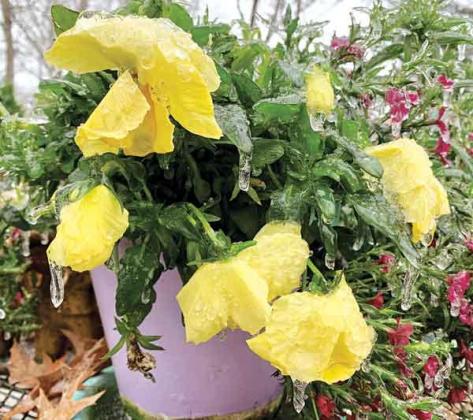
Heather Kirk-Ballard LSU AgCenter horticulturist
The entire state of Louisiana, along with many others, just got an unusual dose of ice, sleet and snow. Despite our valiant efforts to cover and protect plants, some will still be lost to the recent hard freezes.
As the temperatures warm up, it will take several days — maybe weeks — to fully understand the damage this cold weather event has caused. So hold off on the pruning for now. When plants begin their new spring growth, you will be better able to see what damage occurred in the freezes, and pruning will be much more efficient.
Don’t go pulling anything out of the ground yet, either. Many of our cool-season annuals will probably be OK. They are much more cold hardy than other annuals. Violas, pansies, dianthus, foxglove and clematis are alive and will likely bloom again in the spring.
Roots of most hardy plants will be OK, too. With all of the rain that followed the cold snap, our soil is wet, providing protection against freezing temperatures. Even though many of the plants are frozen up top, they are still alive beneath the soil. Rest assured that these plants will return from their roots.
Tender tropical plants melted like the Wicked Witch of the West from Oz. Still, do not be too hasty to get out there and prune. If you are fortunate enough that your tropical plants survived, it’s best to leave the mushy foliage to help protect the crown of the plant.
You may be wondering how to protect your landscape from freeze damage in the future. First, it helps to understand some terminology:
— Tender plants are those that die in freezing winter temperatures. These include herbaceous, tropical and sub-tropical plants.
— Hardy plants can survive our typical winter temperatures. These include most woody trees and shrubs. They are reliably hardy in freezing temperatures and do not typically die.
— Many perennial plants are root hardy, meaning they will return from their roots, crown or other underground parts such as bulbs or tubers.
It is good to know what plants can hold up to before adding them to your landscape. Selections should be hardy enough to survive freezing temperatures below what is normal for your area and tough enough to stand up to our severe summer heat.
The USDA hardiness zone map can help you decide which plants to choose. This map divides the United States and southern Canada into 13 planting zones, with a 10-degree Fahrenheit difference in the average annual minimum temperature between each zone. The higher the zone number, the warmer those temperatures.
For better accuracy, the zones are further broken down into A and B levels, both representing a 5-degree difference, with A being colder than B.
The spectrum ranges from zone 1 in Alaska to zones 12 and 13 in Hawaii and Puerto Rico. Most of the United States lies in planting zones 4 to 8.
Louisiana falls into zones 8 and 9. The north is zone 8a, where average minimum temperatures are 10 to 15 degrees. Central and southern Louisiana are in zone 8b, and average minimum temperatures are 15 to 20 degrees. Coastal areas in zone 9a have average minimum temperatures of 20 to 25 degrees, and the southernmost part of the state is in zone 9b, with average minimum temperatures of 25 to 30 degrees.
The packaging of seeds and plants sold at nurseries and garden centers often indicates the hardiness zones in which they can be grown. For example, a plant marked for zones 5 to 9 means the farthest north it can be grown is in zone 5. It would suffer or die in a colder zone.
A plant is considered hardy if it can tolerate lower temperatures than your area typically receives. Our local nurseries carry many plants that tolerate our low temperatures.
If possible, choose plants that are hardy at least one zone north of where you live. For example, if you live in zone 8, choose plants hardy to zone 7. This gives you a leg up in the event of an unseasonably cold winter.
